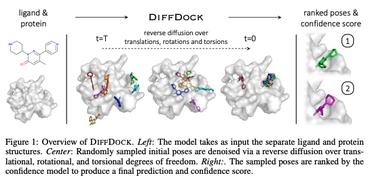Pre-Training on Large-Scale Generated Docking Conformations with HelixDock to Unlock the Potential of Protein-ligand Structure Prediction Models
Protein-ligand structure prediction is an essential task in drug discovery, predicting the binding interactions between small molecules (ligands) and target proteins (receptors). Although conventional physics-based docking tools are widely utilized, their accuracy is compromised by limited conformational sampling and imprecise scoring functions. Recent advances have incorporated deep learning techniques to improve the accuracy of structure prediction. Nevertheless, the experimental validation of docking conformations remains costly, it raises concerns regarding the generalizability of these deep learning-based methods due to the limited training data. In this work, we show that by pre-training a geometry-aware SE(3)-Equivariant neural network on a large-scale docking conformation generated by traditional physics-based docking tools and then fine-tuning with a limited set of experimentally validated receptor-ligand complexes, we can achieve outstanding performance. This process involved the generation of 100 million docking conformations, consuming roughly 1 million CPU core days. The proposed model, HelixDock, aims to acquire the physical knowledge encapsulated by the physics-based docking tools during the pre-training phase. HelixDock has been benchmarked against both physics-based and deep learning-based baselines, showing that it outperforms its closest competitor by over 40% for RMSD. HelixDock also exhibits enhanced performance on a dataset that poses a greater challenge, thereby highlighting its robustness. Moreover, our investigation reveals the scaling laws governing pre-trained structure prediction models, indicating a consistent enhancement in performance with increases in model parameters and pre-training data. This study illuminates the strategic advantage of leveraging a vast and varied repository of generated data to advance the frontiers of AI-driven drug discovery.
PDF Abstract

